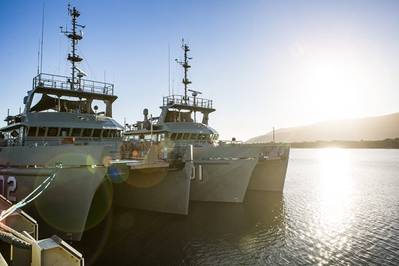Training to ‘fight and win at sea’ occurs across the Navy every day of the year, but how does that concept map to the hydrographic fleet and their motto ‘diligence and skill’? – step into the world of the Navy’s survey motor launches.
HMAS Mermaid, one of four Paluma class vessels, recently completed an intensive five and a half week training program in North Queensland waters in company with her sister ship HMAS Paluma.
The ship and her 15-person crew were put through their paces by Navy’s in-house training and assessment team – Minor War Vessel Sea Training Group.
This training was designed to test the ship’s ability to conduct a ‘Rapid Environmental Assessment’ focusing on a fictitious town that had been affected by a major disaster.
The ship was required to work to ensure the safe and navigable port entry to enable delivery of emergency stores and equipment being used and delivered by Australian Defence Force elements. For this training, the ship was responding to a region impacted by a severe tropical cyclone.
Mermaid’s Commanding Officer, Lieutenant Commander Paul Savage said the challenge was both about skills and speed.
“Both crews performed exceptionally well to ensure that quality navigational information was able to be prepared and delivered on time to safely facilitate the landing of amphibious forces,” he said.
During the period, both crews were also tested on their abilities to respond to simulated damage to the hull, fires on board, flooding, loss of propulsion and other engineering defects.
The crews also had to use their own skills to respond to simulated medical emergencies and the loss of a crew member overboard.
“We have to be able to deliver results every day of the year, whatever the circumstances,” he said.
“Part of being in the Navy is working with the people and resources you have to overcome challenges and keep delivering on the mission.
“This training prepares us for the worst so we can respond calmly and professionally in a real emergency, for us or a community in the region.”
Mermaid and Paluma are fitted with high-resolution multi-beam systems, precise navigation aids and hydrographic data processing equipment. The ships are based in Cairns and operated in pairs to maximise hydrographic specialist skills. Data collected by the ships is forwarded to the Australian Hydrographic Office for publication in navigational products ranging from paper to electronic charts.
Due to their design, they are ideally suited for coastal and shallow water survey which forms a major component of the Australian national charting requirement.
Each ship has a draught of approximately 2.2 metres providing a favourable characteristic in shoaling and reef waters where these vessels conduct a majority of their survey tasking.
Along with four other survey vessels and the Laser Airborne Depth Sounder Flight, Mermaid and Paluma are a key component of the Cairns-based Hydrographic capability maintained by the Navy to support safe navigation and quality nautical chart management.
(CPOB Tony Martin author and photographer)















